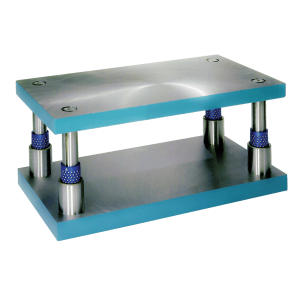Since the first all-steel die set was introduced to the world by Superior Die Set in the middle of the last century, it has overwhelmingly become the material of choice in many facets of the metalworking industry related to tool holding. It is currently the most economical material choice for industrial applications that require a moderate amount of tensile strength, some resistance to impact – or “toughness”, good weldability, and good machinability.
 If you ask any machinist working with a steel die set, steel parallels, or steel fixture plates: “What type of material is that?” – chances are they may not know the particular specification of the steel that they are working with, and simply reply, “mild steel”. Mild steel is a very broad definition of steel with low carbon content. Other commonly used generic names are “hot rolled steel (HRS)” or “boiler plate (BP)”. These are general terms just like “mild steel” that really don’t get into the specifics of mechanical properties or steel chemistry. In reality, there are many different designations, grades or specifications of “mild steel” commonly used within our industry.
If you ask any machinist working with a steel die set, steel parallels, or steel fixture plates: “What type of material is that?” – chances are they may not know the particular specification of the steel that they are working with, and simply reply, “mild steel”. Mild steel is a very broad definition of steel with low carbon content. Other commonly used generic names are “hot rolled steel (HRS)” or “boiler plate (BP)”. These are general terms just like “mild steel” that really don’t get into the specifics of mechanical properties or steel chemistry. In reality, there are many different designations, grades or specifications of “mild steel” commonly used within our industry.
Probably the most common is the ASTM designation for A36 steel. This material standard has very specific, but fairly wide specifications for carbon content as well as alloying elements. It is widely available and is considered a go-to standard material in construction of buildings, since the certification of its mechanical properties makes its engineered use predictable, and therefore safe.
Another common specification is the AISI designation of 1018 or 1020 steel. This material standard is extremely specific as far as chemistry. The drawback, however, is that there is no guarantee on the mechanical properties of the steel.
At Superior Die Set, we take great pride in the material we order because we know from decades of real-world experience that the mechanical properties of A36 are important, yet the consistency in chemistry is desirable, mainly due to the chemistry’s direct relation to the machinability of the steel. Specifically – we know that just specifying A36 is not always good enough. At the low end of the carbon range in the ASTM standard for A36 steel, the carbon content of the steel is so low that the material often becomes gummy during machining. This can result in, at best, inconsistent or slower than expected speeds and feeds – or, at worst, damaged cutting tools or pockets/holes out of tolerance as a result of damaged tooling.
Every piece of #1 steel (A36 Mod) that comes from Superior Die Set is ordered with the specification “A36 with minimum carbon content of 0.15”.
Every piece of #1 steel (A36 Mod) that comes from Superior Die Set is also tested and certified to meet expected mechanical properties AND Superior’s specification for steel chemistry. We can pull certifications for every piece of steel currently in our shop, as well as steel purchased within the last 10 years.
We’ve been specifying and purchasing certified “modified” A36 for years and years. While machine operators at our customers may have noticed the difference, other personnel not working directly with Superior’s steel may not have realized the true value of #1 steel (A36 Mod) purchased from Superior Die Set.
The bottom line is that the #1 steel (A36 Mod) we use in every die set and plate saves our customers money in the long run. Our customers are, and always have been, truly receiving a “Superior” steel.